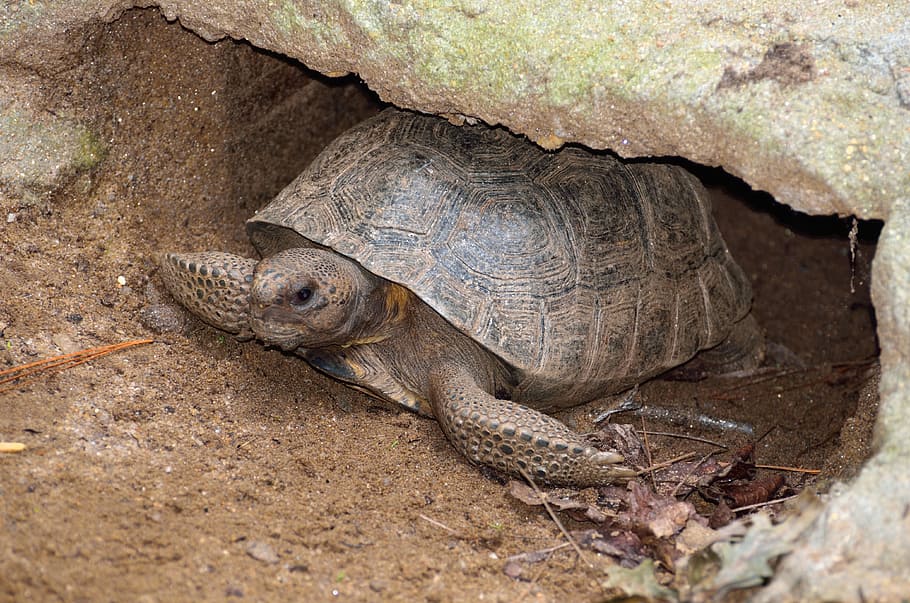
The U.S. Fish and Wildlife Service said last week the eastern population of gopher tortoises – those east of Alabama’s Tombigbee and Mobile rivers – is “robust” and the species in that segment is no longer a candidate for federal listing.
The data-based findings, which do not change state regulations protecting gopher tortoises in Georgia or other states, will be discussed in a virtual public meeting Dec. 13.
Credit for the good news on gophers is shared by Georgia’s Gopher Tortoise Conservation Initiative. The collaboration that has grown to nearly 30 agencies, conservation organizations, companies, foundations and landowners has been working since 2015 to keep the state reptile off the federal list. The larger aim: preserving Georgia’s economic viability and other native animals and plants in need of conservation.
Commissioner Mark Williams of the Georgia Department of Natural Resources said initiative members realized they could work together to hopefully avoid listing the tortoise or do nothing and risk facing increased federal regulation that could affect key parts of the state’s economy if the species was listed.
“While they knew the listing decision would not rest solely on efforts in Georgia, partners brought their unique strengths to the table, set strategic conservation goals and made great strides toward those goals,” Williams said. “In the end, I think that effort helped significantly. This collaborative approach shows tremendous promise as a model for successful wildlife conservation going forward.”
The coalition’s primary focus has been permanently protecting 65 viable gopher tortoise populations spread across the species’ range in Georgia. The best available research suggested that 65 are needed to ensure the tortoise’s survival in the state. A minimum viable population is defined as 250 adult tortoises.
When work began, Georgia had 36 protected populations. The total is now 62, just three shy of the goal. Other additions are possible soon.
The progress has been achieved through range-wide surveys to identify tortoise-rich tracts, extensive coordination with landowners and nonprofits, strategic planning, and deep support, varying from foundations and federal grants to the U.S. Defense Department and the Georgia Outdoor Stewardship Program. Results include highlight acquisitions such as Ceylon and Alapaha River wildlife management areas, plus conservation easements on private lands. All help make sure gophers are here to stay.
The Fish and Wildlife Service, which is part of the Georgia initiative, said partnerships contributed to conserving the species and even helped document populations that weren’t known about.
Those partners include the Knobloch Family Foundation, which works with others to finance critical conservation opportunities and incentivize land stewardship for species and habitats.
Director Eleanor Ratchford said that when the private foundation was approached to support the initiative in 2015, her father, Carl Knobloch Jr., “immediately saw the potential to not only protect gopher tortoises but also many other species that depend on tortoises, as well as providing more public recreation land.” Ratchford called the effort “a tremendous example of what is possible when so many people and organizations come forward and collaborate around a common goal.”
Gopher tortoises are found in the Coastal Plain from eastern Louisiana to western South Carolina and southern Florida. The only tortoise native to the eastern U.S., gophers are a keystone species primarily because the long burrows they dig are used by more than 300 species. Some such as the eastern indigo snake are federally listed. Others, including the gopher frog, are candidates for listing.
In its recent announcement, the Fish and Wildlife Service said gopher tortoises in Louisiana, Mississippi and western Alabama are a distinct population segment and will remain federally listed as threatened.
Matt Elliott, an assistant chief with DNR’s Wildlife Conservation Section who helped create the Gopher Tortoise Conservation Initiative, said the determination to not list tortoises in the eastern part of their range doesn’t mean the work is done. The species still faces major threats, including habitat loss. Elliott noted that the Fish and Wildlife Service also stressed the need for continued protection in states.
“It’s still going to be a high-priority species in Georgia’s State Wildlife Action Plan and remain on the state-protected species list,” he said. “We’re going to continue to work with landowners for gopher tortoises. We’re going to continue managing for them on state property.”
Started by DNR, the Fish and Wildlife Service, and the Defense Department, the initiative includes:
- Athens Land Trust
- Bobolink Foundation
- Georgia-Alabama Land Trust
- Georgia Chamber of Commerce
- Georgia Conservancy
- Georgia Department of Transportation
- Georgia Forestry Commission
- Georgia Power
- Georgia Wildlife Federation
- Knobloch Family Foundation
- Open Space Institute
- Pattillo Industrial Real Estate
- R. Howard Dobbs Jr. Foundation
- Robert W. Woodruff Foundation
- Southern Power
- Tall Timbers
- The Conservation Fund
- The Jones Center at Ichauway
- The Nature Conservancy
- The Orianne Society
- Turner Foundation
- U.S. Department of Agriculture (Natural Resources Conservation Service)
- U.S. Endowment for Forestry and Communities
- U.S. Forest Service (Forest Legacy Program)
- WildArk
For further information on the Fish and Wildlife Service’s notice of findings regarding gopher tortoises, read the Federal Register notice at www.regulations.gov and these frequently asked questions. The online public information meeting is set for 7-9 p.m. Dec. 13. Registration details are available at www.fws.gov/project/gopher-tortoise.


Bulloch Public Safety
Several Arrested in Bulloch for Narcotics Trafficking After Citizen Complaints

Bulloch Public Safety
12/19/2025 Booking Report for Bulloch County

Chattooga Local News
Trump signs executive order reclassifing marijuana

Bulloch Public Safety
12/18/2025 Booking Report for Bulloch County

Bulloch Public Safety
11/24/2025 Booking Report for Bulloch County

Bulloch Public Safety
12/12/2025 Booking Report for Bulloch County

Bulloch Public Safety
12/01/2025 Booking Report for Bulloch County

Bulloch Public Safety
12/11/2025 Booking Report for Bulloch County

Bulloch Public Safety
12/16/2025 Booking Report for Bulloch County





